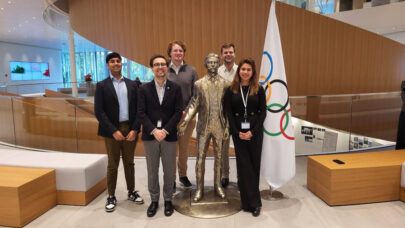
There are myriad potential benefits of blockchain in supply chains, as well as challenges to its implementation. However, a better use of supply chain managers’ time would be to “look back to a time when radio frequency identification (RFID) was the technology of the supply chain future, explore what really transpired and reflect on where RFID brought benefits to businesses”.
These are the words of Professor Ralf W. Seifert and Richard Markoff writing in The Digital Supply Chain Challenge: Breaking Through, which has been published by IMD this week.
They say the analogy between the technologies can teach managers many valuable lessons about finding the right applications for innovative technologies, blockchain being just one in a long list of applications, which is “embryonic and in flux” in nature, and the cause of “a crowded and growing ecosystem of vendors”.
Many such applications touch on the areas of Industry 4.0 or ecommerce.
The authors say that “some of the media coverage is breathless and borders on hype” in reference to blockchain, whilst “others are more sanguine about the potential of blockchain.” However, what hasn’t been talked about is “the arc of the RFID story”, where it sits today and how this can offer insights into how new technologies can find their “sweet spot”.
Blockchain: déjà vu?
As a new technology that will revolutionize supply chains through improved visibility, data reliability and productivity, blockchain is “eerily reminiscent of the increasing popularity of radio frequency identification in supply chain about two decades ago”.
The way blockchain has come on the scene and promised to revolutionize the workings of everything from safety and sustainability data to supply chain financing is “dizzying”.
Writing in a chapter entitled “RFID: Yesterday’s Blockchain”, the authors say taking this perspective could serve as a major step towards more efficient and high-performing supply chains, “even if [blockchain technologies] do not live up to their initial expectations”.
RFID: razor-sharp security that took some unexpected twists and turns
RFID promised great benefits in the early 2000s, in the context of being touted as the new bar code. It would be better because of its greater efficiency.
In retail supply chains, expectations were particularly high and well publicised. In 2003, both Walmart and UK retailer Tesco ran pilots with Gillette. They were taking a novel approach to addressing the razor shrinkage problem, the shaving implement being a notorious target for shoplifters due to their high price and small size.
RFID in this arena did not take on, largely because of pressure from privacy groups and lawmakers (cameras on the tag can photograph its handler).
“By just focusing on the consumer mass channel, one could be forgiven for thinking that RFID has been an abject failure. But this is not the case,” the authors explain in the book.
An exploration of RFID’s use at Zara, Decathlon and adidas is behind the observation that “there have been some notable successes in RFID implementation that have delivered the expected benefits of productivity and inventory accuracy.”
Where RFID found its sweet spot
At Zara, which applies RFID tags to all its products, items are scanned on receipt using handheld wands, and the transactions are automatically recorded. Inventory cycle counts are thus “fast and accurate, turning a 40-hour job into a 5-hour one.”
Behind Decathlon’s doors, an RFID initiative than began in 2013 is described as having been “a resounding success” with inventory, accuracy and sales growth due to improved on-shelf availability statistics to prove it.
For adidas, RFID was one of the fundamentals underpinning the company’s success in implementing the click-and-collect and ship-from-store omnichannel models in Russia, which the book explores in great depth.
In the end, RFID found its niche. It was in higher margins, moderate volumes and verticalized supply chains.
Lessons for blockchain
Many of the elements of the RFID experience provide keys to the future construction of a blockchain sweet spot:
- RFID has become a useful part of the supply chain toolbox while not being the revolution it was once promised to be. Blockchain might follow suit.
- Just as RFID was beset by competing standards for hardware, software and data management, blockchain could suffer from the variety of platforms coming online, such as Hyperledger and Ethereum, each vying for blockchain’s attentions, as they seek to become the universal standard for its application.
A blockchain solution is only effective if all the actors in the chain participate, from one end to the other. If a vendor has several customers asking to work on several competing standards, it will create a real barrier to implementation. None will be big enough to scale, and the actors will not want to adapt to each standard simultaneously.
- RFID was initially applied quickly and widely. Blockchain, by contrast, should not be applied “indiscriminately”, as this could end up “souring the supply chain community on the technology”.
It is still early days for blockchain, but its benefits are not about to be challenged: it is autonomous, and its extended networks bring together information and transactions from diverse actors across the supply chain.
If a slow and incremental implementation proves to be blockchain’s destiny, this does not undermine its importance, particularly if set alongside TCP/IP’s journey of the same nature, the authors point out. (TCP/IT became the groundwork for the development of the internet.)
Blockchain may not end up being the disruptive technology we thought it would be, and yet it might well prove to be a foundational technology from which many innovations spring.
The Digital Supply Chain Challenge: Breaking Through takes the form of a dip-in, dip-out handbook of advice for supply chain managers looking for some grounding principles as a wave of digital technologies crumbles many of the historical foundations if supply chains.
The authors scatter real-life cases of companies that faced the challenge of relevant transformations along a path, as they walk readers through the importance of both successfully executing the fundamentals of supply chain management, and assessing where tangible value is to be gained from making a business case for certain technological advancements.


